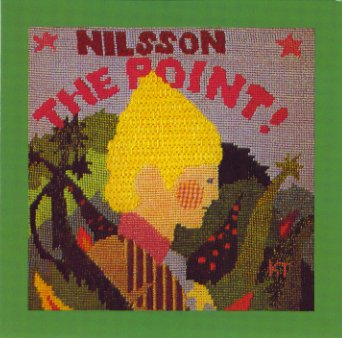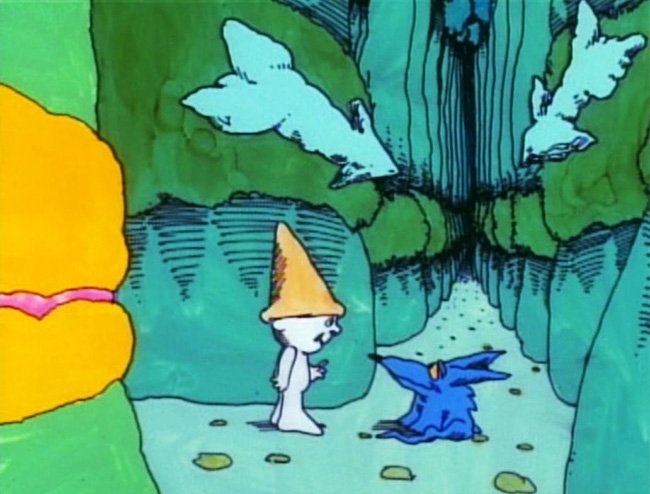
Everything has a point if you look closely enough. This was the revelation singer/songwriter Harry Nilsson discovered while tripping on acid and wandering into the woods near his home in early 1970. The trees had points, and their branches had points, and every shrub and bush and all the houses in the distance, too. Therefore, everything must have a point. The psychedelic breakthrough led straight to an album called The Point, and subsequently to an animated made-for-TV special – the first of its kind – also called The Point (1971). The album is usually filed away in the children’s section, and rock fans would consider his subsequent album, the classic Nilsson Schmilsson, more worthy of discussion. But the funny thing about making something for children: the children grow up and look back on it with nostalgia, and they expose their children to it, and on and on. In many ways, Beatles fan (and drinking pal) Nilsson had made his own Yellow Submarine, something which could please young and old and earworm its way into the consciousness of future generations. Granted, The Point is a bit more obscure, but if you talk to the right people, they love it. (Digression: on a music board I used to frequent many years ago, one of the contributors happened to mention she was one of Nilsson’s children. What followed was a flood of comments with love for Nilsson’s music, and The Point in particular.) I have recently had a son, and I plan on exposing him to The Point. In fact, I tried to with this viewing – but the three-month-old snoozed through the whole thing. Maybe when he can see a few feet past his head I’ll give him a second chance.
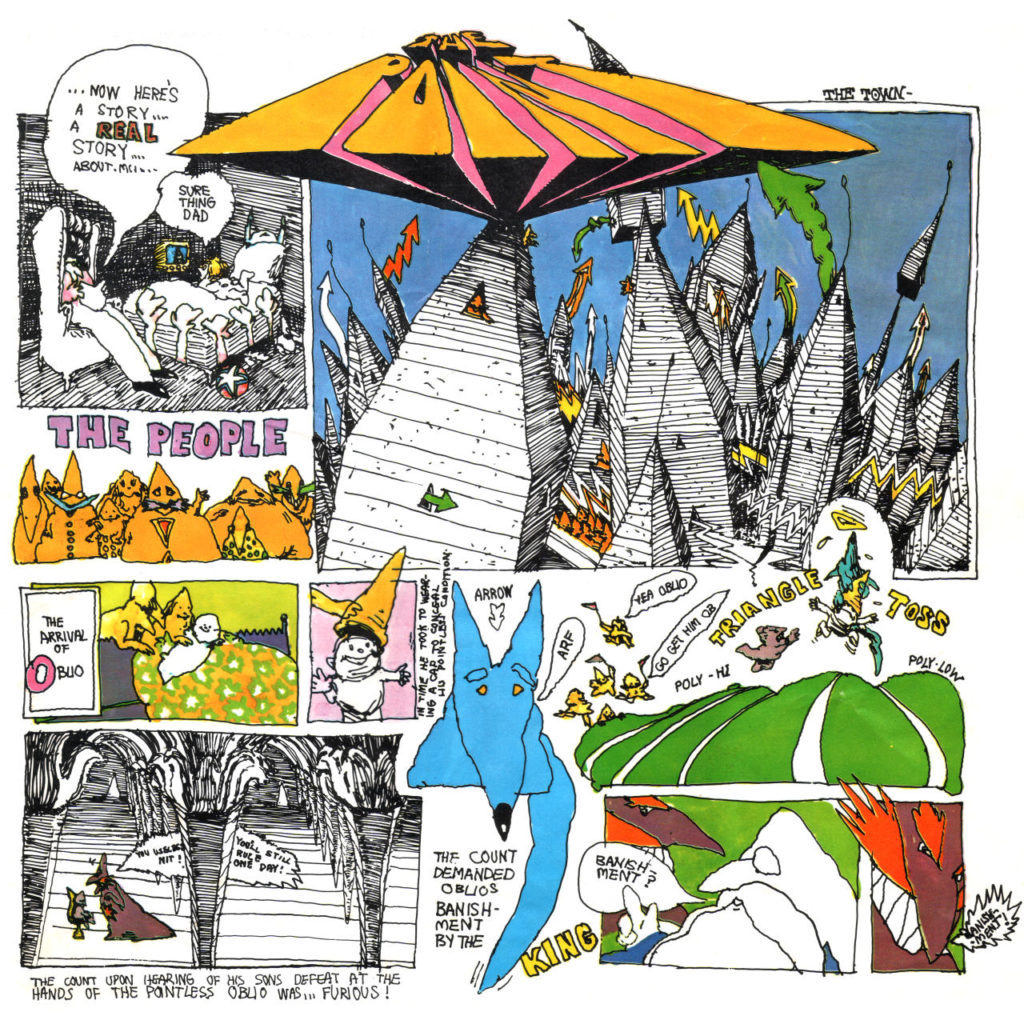
Part of the Gary Lund-illustrated comic inserted into copies of Nilsson’s “The Point” LP. The drawings were inspired by the then-still-in-production animated film by Fred Wolf.
The album, even if it is a storybook interrupted by songs, ranks among Nilsson’s best, and it was produced during what is considered his creative peak. His songwriting had matured while his voice retained the sweetness that contributed to the Grammy win for “Everybody’s Talkin’,” the Midnight Cowboy hit. The record’s cover features needlepoint artwork (get it?) and an LP-sized comic book that skips quickly through the plot. The songs are uniformly excellent, though only the first three seem to actually be about the story and characters. It doesn’t appear that all of them were originally intended for The Point: for example, the stream-of-consciousness standout “Think About Your Troubles,” which explains how your salty tears fit into the grand scheme of nature, had been kicking around Nilsson’s head since at least late 1969. But it’s much the case as it was with Sgt. Pepper: John Lennon once pointed out that the Beatles hadn’t really written a concept album, since so few of the tracks are about Sgt. Pepper, but “it works, because we said it works.” Similarly, The Point, as a record, works; the songs seem to fit into the story, even though a glance at the lyrics reveals more to do with Nilsson’s preoccupations with love, heartaches, and break-ups. The spacing of the storytelling and the songs is such that whenever Nilsson begins to sing and the piano kicks in, it’s a kind of sonic relief, like cool water rushing in; and further unity comes with the instrumental versions of the songs, arranged by George Tipton, that play during the narration. Nilsson reads his fable to the listener while doing all the voices. You can even hear him turn the pages of his script. He was always something of a one-man band; in many of his records, those backup singers you hear are just him. Likewise, the album has an intimate and personal touch. Such would remain the case with the animated film, even though in this case it would be a different one-man-band: Fred Wolf.
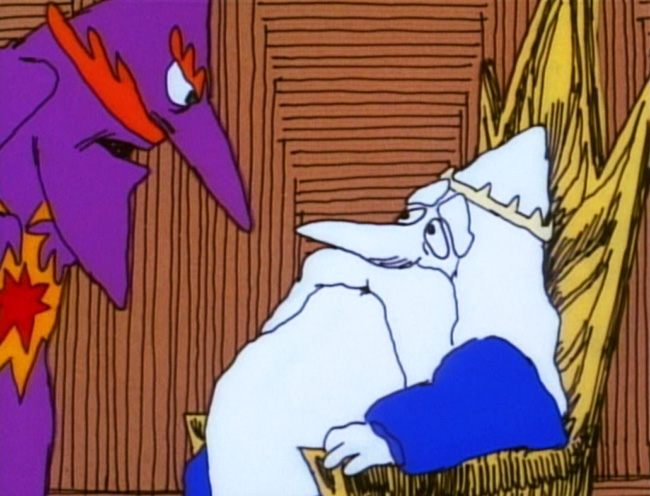
The evil Count (Lennie Weinrib) and the King (Paul Frees).
Nilsson conceived The Point as both an album and an animated film. He convinced ABC to buy the project only after cornering the network’s commissioning editor, Marty Starger, on a plane flight from LA to New York. The feature was slated in as an ABC Movie of the Week, to debut Christmas 1970. This date would later be pushed, as the realities of completing a full-length hand-drawn animation film began to settle in. Still, the right man was hired for the job. Nilsson had wanted Wolf to animate The Point from the start, having seen his Oscar-winning short film “The Box.” Wolf’s style is instantly recognizable to anyone who grew up in the 70’s or 80’s; for one, he created the famous “how many licks does it take to get to the center of a Tootsie Pop” commercial. Wolf, inspired by how Nilsson was going to record the whole album on his own, decided that he would draw the entire film on his own. Such a remarkable feat is seldom attempted, though Bill Plympton would later make a career of it. What makes Wolf’s accomplishment extra special was the extraordinary time constraint. In Alyn Shipton’s Nilsson: The Life of a Singer-Songwriter, Wolf said, “It’s certainly not the best animation in the world, but this was my challenge. I better come through with a style that is going to be consistent for 74 minutes of animation, in other words, a total of 28,000 drawings which I did in 34 weeks. The hand can get numb just thinking of it. The fact that I was doing it all myself dictated a style, which I think is effective.” Indeed, there are only a few moments in the film where you can sense the animator’s exhaustion, namely a strange brief dance number between two creatures that look like the love children of Donald Duck and Mickey Mouse. But such bizarre moments only add to the trippy feeling of the film as a whole.
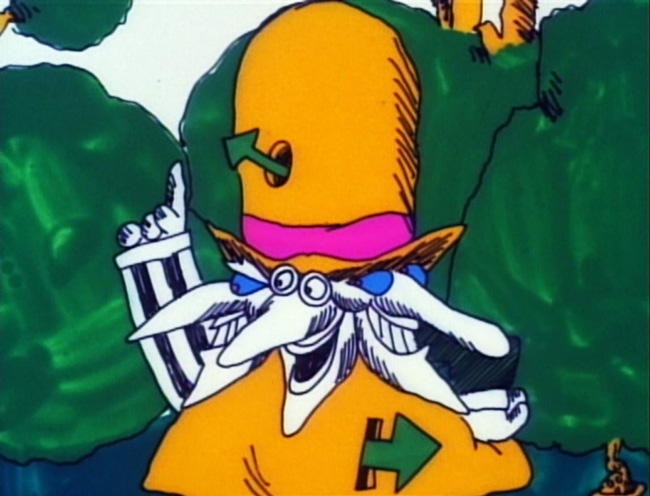
The Pointless Man (Paul Frees), who demonstrates that having too many points is as good as having no point at all.
The completed film finally appeared on February 2, 1971. For this initial airing, Midnight Cowboy co-star Dustin Hoffman played the narrator, who in the film is a father telling the story to his young son. Because his contract only extended to the single broadcast, in subsequent airings he would be replaced by Alan Barzman (a veteran of Wolf animation), Alan Thicke, and finally Ringo Starr. (When I saw this as a child, it was the one with Thicke.) Ubiquitous voiceover artist Paul Frees plays a host of characters. Mike Lookinland – Bobby from The Brady Bunch – is the protagonist, Oblio. And what a great name that is. Oblio has the rounded (“pointless”) letters o and b, but of course b does have a point, as does the l. In other words, even too-round Oblio has a point (or two), which is the point of the story. Oblio, in Nilsson’s tale, is born in a town where everybody has a point on top of their head; all the buildings have points too, and even the pets, like Oblio’s dog Arrow. To disguise Oblio’s freakishly round head, his mother gives him a pointed hat. But his roundness bothers the son of the evil Count – especially when Oblio beats him at a game of ring toss – so the Count urges the King to enforce the only rule which the kingdom has, the rule which states that everything must have a point. Oblio is exiled into the Pointless Forest with only Arrow as his companion, and there he encounters a number of strange characters and creatures before having his own revelation, like Nilsson’s, that everything does have a point, including Oblio.
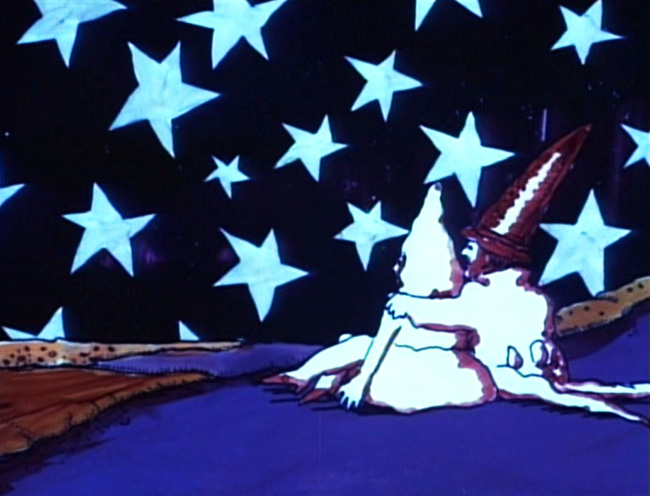
Animation accompanying Nilsson’s “Are You Sleeping?”
Part of what makes the film so endearing is that it has the same gentle and witty qualities as the album, captured in the script and the characterizations, particularly those of Paul Frees. When Oblio is born, his father says, “Hi there, Oblio,” as though he’s greeting a friend at work. Similarly, Oblio’s banishment from the town is treated as something disappointing and sad but not catastrophic; the villagers are simply perplexed that a time has finally come to enforce a law they never thought would be enforced. Nonetheless, they’re encouraging to Oblio – giving him and his dog candy, and waving goodbye, as he heads off toward possible starvation and death. Well, it’s a children’s fairy tale; being exiled to the woods is pretty common. Most of the strange beings that Oblio and Arrow encounter in the forest feel random and thinly conceived, though the watercolor-speckled animation and Nilsson’s irresistible tunes compensate. By the end – that is, the “Destination Point” – any child will be able to tell you the point of the tale. And if they come away with an appreciation for the genius that was Harry Nilsson in his prime, all the better.
